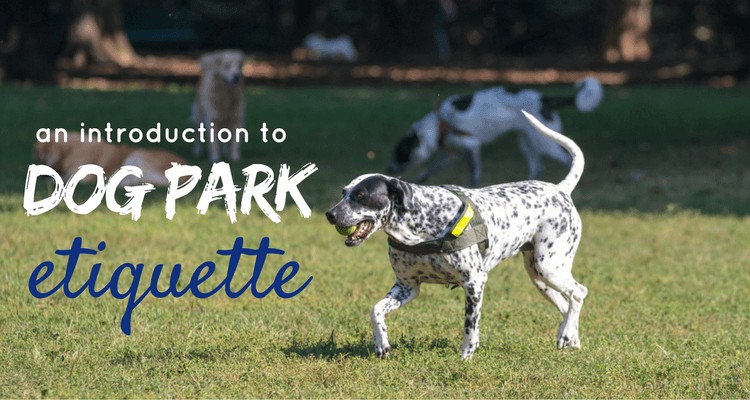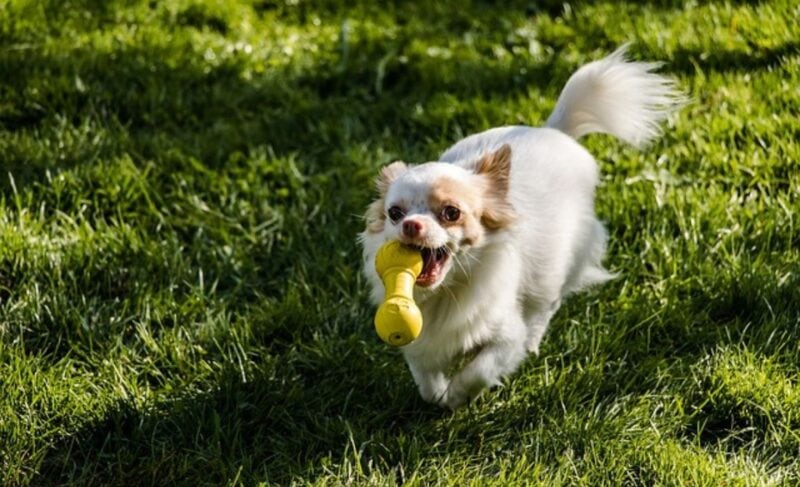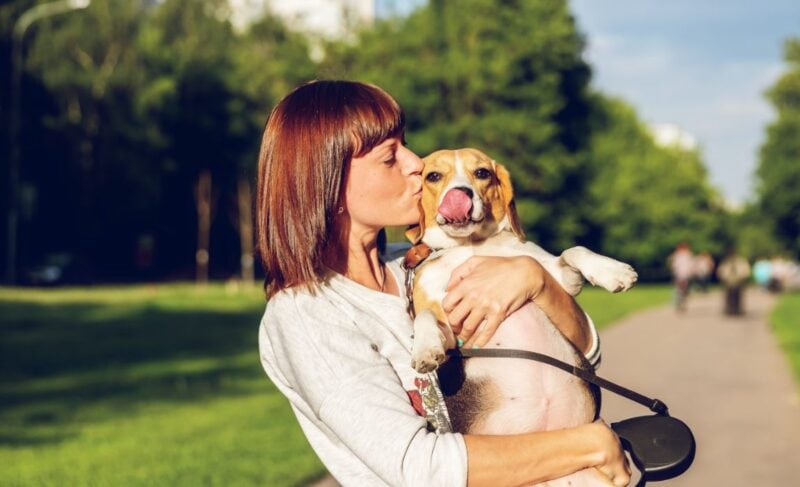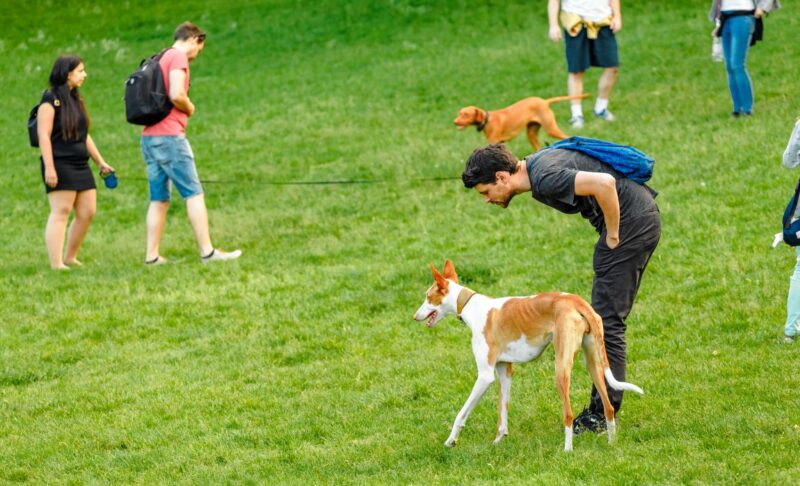Dog parks can be a great place to exercise your dog and let them play off-leash with their doggie peers but they also can be a disaster waiting to happen, full of ill-behaved unvaccinated scoundrels running amok while their owner flips through Instagram!
What’s an owner to do?
Don’t fret – just make sure you understand what you’re getting into when you roll up to the dog park, and plan accordingly.
To help you out, we’ve put together a guide to help you decide whether or not the dog park’s for you, what to expect, and how to tell the difference between playing and real fighting.
Pros and Cons of Visiting the Dog Park
The truth is that not all dogs will enjoy spending time at the dog park. It’s important to remember that you’re going to the dog park for your dog’s sake. Making the best decision for your dog is important.
PROS
- Your dog can play off leash
- Your dog can socialize with other dogs
- Many good dog parks have water or agility equipment to enjoy
- It’s a good place to work on extremely high-level training for your dog – getting them to come when called while ignoring enticing distractions at the dog park is PhD level work!
- Your dog can get some major exercise chasing his buddies
- You can meet with other dog owners to talk with, learn from, and arrange play dates with
CONS
- Other dogs may be totally out of control since they are not on leash, and many may not be well-trained enough to respond to their owners
- Other dogs may be unvaccinated or carry parasites, posing a threat to your dog
- Your dog might be uncomfortable around such a huge group of other dogs (it’s like going to your first house party if you grew up homeschooled)
- Other dogs of various play styles and sizes might overwhelm your dog
- Intact (unneutered or unspayed) dogs may be there
- There’s a potential for over-excitement, leading to aggressive or rude incidents
Personally, I am very careful when deciding which dogs I bring to the dog park and when. I don’t bring my young lab to the dog park on nice Sunday afternoons, because Sundays are packed with pooches, and she gets overwhelmed with the huge number of dogs there.
She tends to get mouthy and barky when she’s overwhelmed, and this annoys other dogs. We instead go closer to dark on weekdays, when she can run with one or two other dogs that are still there.
I am also quick to leave the dog park if things feel or look off. As a student of dog body language, I find that the dog park is a great learning place for me and my dog – but that also means acting on my knowledge and leaving when I feel that another dog or owner is potentially posing a threat.

Are Dog Parks Safe? Not For Everyone: When to Pass Up the Park
It’s probably best not to bring your dog to the dog park if your dog is:
Under 6 Months Old
Young dogs are more likely to be bullied or overwhelmed. It’s also a potentially life-or-death mistake to take your dog to the dog park before their vaccines are complete. Check with your vet before trying out the dog park.
Young dogs are also more likely to react poorly to a single bad experience at the dog park, potentially creating issues with a dog for the rest of his life!
Undersocialized or Fearful of Other Dogs
Dog parks are not a good way to start socializing a dog or help them get over an existing fear of other canines – it can actually have the opposite effect.
Enroll yourself in a dog training class like obedience or agility to get that instead (Note: to clarify, dog parks are great for continuing socialization – but more controlled environments with fewer dogs are best for young or nervous dogs with existing socialization issues).
Under 30 Pounds
Unless your dog park has a small-dog area, it’s best to leave your small dog at home.
Even if your Yorkie doesn’t know her size and can play well with your neighbor’s Rottweiler, it’s just too easy for things to go wrong. Other big dogs might not know how to react to a small dog and might even think of her like a prey animal. It’s also easy for your little dog to just get run over by rude big dogs!

Extremely Excited by Other Dogs
While this sounds like exactly what a dog park is for, it’s better to train your dog to be able to calm down around other dogs before braving the dog park.
A few doggie friends and scheduled play dates will help a dog like this avoid getting over-excited and resort to being rude. This frantic behavior can be stressful for the dog, even if it looks like they’re having fun.
New To Your Home
Don’t bring a new shelter dog to the dog park until they’re very comfortable with you and in their new home. You don’t know if they’ll come when called or how they’ll react to a situation that they can perceive as stressful.
What You May See at the Dog Park
Here are a few things you might find at the dog park when you visit for the first time.
- Water Stations. Not all dog parks have water stations, but many do, allowing for an easy way to hydrate your pooch! Alternatively, you may want to bring your own dog-friendly water bottle in case the dog fountain is out of order or crowded.
- Signage. Most dog parks will have signs displaying the rules of the dog park and hours.
- Agility Games and Equipment. Some parks will have agility equipment – if you see these structures, definitely give them a try!
- Different Runs for Different Sized Dogs. Some dog parks have separate areas for small breed dogs, as opposed to larger canines. This allows dogs to play with their respective pooch peers safely.
What Does Good Dog Play Look Like at the Dog Park?
If you do decide that a dog park, it’s important to know what to look for in good dog play as opposed to an escalating encounter.
Unfortunately, you can’t just watch for a wagging tail! Dogs wag their tails for all sorts of reasons. It’s like when people smile or laugh. Sometimes, people laugh when they’re nervous or being mean. Laughing doesn’t always mean someone is having fun – and a wagging tail is the same.
Watching videos of dogs playing like this one below will help hone your eye!
These characteristics, when put together, suggest that doggie play time is healthy and fun for both parties.
We’ve put together a list of what behaviors to look for that indicate happy, normal canine play!
- Loose, Waggy Postures. A wagging tail in general isn’t a surefire way to know a dog is happy. But a loose, sweeping tail wag that wiggles the whole butt definitely indicates a happy dog!
- Taking Turns. Even mismatched play partners should be able to take turns in polite dog play. This means dogs take turns chasing each other or being on top while wrestling.
- Bouncy, Inefficient Movements. When dogs aren’t playing and are actually trying to hurt each other, you will notice a lack of the spinning, bouncy, inefficient movement that is characteristic of play. Seeing dogs spin, bounce around, and generally waste energy is a good sign that they are playing well. Playing dogs often will circle back to their play partner, pause and wait for them, and look back to make sure they’re being pursued. If the game were serious, you wouldn’t see these behaviors!
- An Open-Mouthed, Wide “Play Grin.” While dogs don’t exactly smile, they do exhibit a play grin. Dogs with closed mouths or with their lips pulled forward are more tense and not having as much fun playing. Watch out for this!
- Play Bows. Play bows are generally a cute, obvious way that dogs say “Hey, it’s ok. We’re just playing here.” When accompanied with a loose, wagging tail and a big grin, a play bow is a very obvious sign that a dog is playing. Dogs may simply slam their front feet down for a second, or they might bend into a full play bow with their elbows on the ground and their butt high in the air.
- Self-Handicapping. In great dog play, the dogs will take turns rolling onto their backs or allowing their partner to “win.” This shows trust and mutual agreement that this is play between two partners.
- Returning For More. This seems obvious, but dogs that are enjoying their play will come back to their partner. Coming back for more doesn’t guarantee that a dog isn’t over-aroused or actually fighting, but it is a good indicator that they’re not overwhelmed or frightened. When a dog returns to play with bouncy postures and a big play grin, you can be fairly confident it’s a good time!

Dog Park Aggression: Warning Signs That Your Dog Might Be Stressed
Keeping an eye out for danger designs is key to catching situations before they turn into full-blown fights. Learn to recognize doggie warning signs before dogs get to the point of growling, snarling, snapping, lunging, or biting.
These signs of stress are good for any dog owner to know, both in and outside the dog park, so that you can spot signs of stress at Christmas dinner, the vet’s office, or at the coffee shop. Knowing how to tell your dog is stressed will help you make her life better!
- Hackles Up. The fur along a dog’s spine, especially above their shoulders, is called their hackles. This chunk of fur can become raised, indicating overarousal, stress, or even aggression. Identifying raised hackles can be hard in very long or very short-haired breeds.
- Dandruff. As odd as it sounds, many dogs start to shed dandruff when they’re stressed. I’ve seen dogs at the shelter I work for will start to shed dandruff around their harness if they get too close to things that scare them. If you notice that your dog suddenly is covered in dandruff, remove her from the situation.
- Ears Back and Tight Mouth. Both of these are generally not good signs for a stressed dog. Ears that are pinned forward, back, or out to the sides are all bad signs. A dog’s ears should be loose and mobile, though not constantly swiveling. Their mouth can be closed, but a clenched mouth with pursed lips is no good.
- Tense or Low Postures. When that loose, waggy, bouncy movement disappears, pay attention. Dogs that start to move slowly or sharply aren’t having a great time. Crouched dogs often are also uncomfortable – the exception being herding breeds that may be performing a play-stalk behavior. Play-stalking is still a behavior that can be misinterpreted as rude by other dogs, so it’s really not ideal. If you notice your dog is tense, low to the ground, hiding under things, or staying very near you, it’s time to pack up and leave.
- Wide Eyes. Generally, you shouldn’t be able to see the whites of your dog’s eyes. When their eyes are bugging out, they’re probably stressed. Give them a break!
- T-Stance. This is a universally inappropriate way to play. We don’t like to talk much about dominance in dogs – it’s just not a helpful framework to use and often leads to pain- and fear-based training methods. However, some dogs do attempt to take control of a situation by gaining the higher ground over another dog. Often, the offending dog is uncomfortable and lacks confidence. It also can be a pre-mounting behavior performed by any combination of sexes. Standing over another dog like this is rude and can lead to retaliation.

These signs are all good to know about so that you can intervene before the fur starts flying.
If you do find yourself in the middle of a canine tussle, be careful. Read our guide on how to break up a dog fight safely and effectively without losing a finger!
Other Things to Keep in Mind at the Dog Park
Leave the Food at Home. As another general guideline, keep food and toys away from the dog park. Even if your dog passed puppy kindergarten with flying colors and is a sharing pro, other dogs may struggle with resource guarding. It’s best not to risk it
Dogs Have Different Play Styles. It’s also important to be aware of your dog’s play style and personality. Some breeds are more prone to body-slamming (boxers) or heel-nipping (heelers) behaviors that other dogs may perceive as rude. It’s not that your dog isn’t playing – it’s that it might not be fun for her playmates!
If your dog has a unique play style connected to their breed, consider connecting with breed groups to let your dog channel their unique energy!

Know Your Dog’s Personality. In addition to play style, be aware of your dog’s personality. My 13-year-old lab used to be awesome with other dogs. Now that she’s getting older, she is quick to get annoyed with other dogs. She’s happy enough to play for a while, but she’s not very patient when other dogs pester her.
Consider Visiting at Off-Peak Hours. As mentioned already, visiting the park at off peak hours is ideal for dogs that are overwhelmed easily, but it also gives you a chance to take in the dog park and get your bearings. According to dog park statistics, over 70% of dog park usage occurs on weekends. So, if you want to visit the dog park when things are a bit more relaxed, consider a weekday visit.
On vs Off Leash Areas. Once you enter a designated off leash area, make sure to take your dog’s leash off right away, as dynamics between on and off leash dogs can cause stress and aggression issues.
What if Things Go South at the Dog Park?
You may notice that your dog has suddenly gotten tense with a tight mouth and that her tail has become tucked. Maybe the dog she was just playing with doesn’t seem to notice, and your dog barks and snaps at the other dog when he tries to paw at her again.
Did your dog just start a fight? Not necessarily. Dogs can give each other “corrections,” which are ways for them to tell each other “no.” It takes a practiced eye to know what an appropriate level of correction is given the infraction, so it’s a good rule to remove your dog from the park if she’s giving or taking corrections from other dogs.

A correction is different from a fight in that it’s usually one-sided and usually only lasts a split second. In a perfect world, your dog barks at the other dog and the other dog backs off, and they both can go on with their days. Even with these minor encounters, it’s still a good idea to leave – your dog is likely pretty stressed.
Even if you do everything right, it’s possible to end up in a bad situation at the dog park. It’s just too hard to pay attention to every single dog all the time, and things can escalate quickly. It’s best to be very in-tune and attentive so that you can avoid incidents before they happen.
How to Handle a Full-On Fight
If your dog does get into a full on tussle, do not put your hands into the fray for any reason. There’s a very good chance that you’ll be bitten.
Instead, you can try:
- Spraying the dogs with a hose
- Blowing an air horn
- Yelling at them
This should startle the dogs enough to get them to stop fighting in most cases. Keep your cool and don’t make yourself into another victim. If you’re interested in learning more about breaking up dog fights, Dr. Sophia Yin has a great article that goes into more depth.
Dog Park Do’s and Don’ts
DO:
- Pick up after your dog. Of course this is a no-brainer, but always clean up after your dog (this goes for outside the dog park too).
- Keep an eye on your dog at all times. This isn’t the time for catching up on social media – your dog needs your attention.
- Make sure your dog is up to date on their vaccinations and that you’ve consulted your vet to ensure that your dog is good to go at the dog park.
- Introduce yourself to other owners – the dog park is a great spot to make new human friends too!
- Ensure that your dog responses to basic commands like “come” and “leave it” before bringing them to the dog park.
- Honor the official dog park hours and be respectful of the rules.
- Be prepared to listen to criticism. If another owner says something about your dog’s behavior, don’t immediately dismiss them. Sometimes others see what we can’t or are unwilling to see in our fur babies! Consider their perspective and whether there may be merit to it – they may simple be trying to help. If you don’t agree, consider getting a 3rd party opinion. Regardless, always be polite.
DON’T:
- Be afraid to leave if things don’t feel right. Trust your instincts – if the mood in the park is off that day, just take off.
- Correct another dog’s behavior. Just as you might get pretty irked at someone else disciplining your human child, most owners won’t be happy if you try to discipline their dog. If you’re not happy with another dog’s behavior, just leave the park.
- Bring toys or treats into the park, as they can distract other dogs and cause potential food possession issues.
- Force your dog into situations they are uncomfortable in – the dog park isn’t for everyone!
- Take a dog under 6 months old. Pups aren’t fully vaccinated yet and can easily get knocked over or hurt my full grown canines.
- Bring un-neutered or un-spayed dogs into the dog park. We don’t want any accidental puppies!
- Bring sick dogs to the dog park. Diseases and parasites (like fleas, lice, or ticks) can be passed to other pooches, and issues like arthritis or hip dysplasia can be exacerbated by rough play at the dog park.
- Bring small children into the park. Fun-frenzies dogs can easily knock children over, so it’s best if they stay out. Some dogs also might not be properly socialized towards small children yet.
- Hesitate to let a human know if their behavior is off. Confrontation is a difficulty for many of us, but a polite and tactful approach can go a long way. Many owners may not realize that it’s not appropriate for them to eat their lunch in the dog park, or that their small breed dog would be better suited in the small breed enclosure area. Whole Dog Journal offers some great suggestions for how to discreetly and kindly offer advice to uninformed owners.
- Bring in a dog with a resource guarding problem. If another owner has treats or a toy, resource guarding can be an issue, so don’t bring in a dog that’s known to have this problem.
- Let your dog be a bully (or get bullied). Since we humans don’t always understand dog behavior, some owners are temped to just let the dogs “work things out.” However, as we detail above, bad behavior is bad behavior – especially if constant nipping and pouncing is making another dog uncomfortable.
- Leave prong collars or harnesses on. Prong harnesses and collars are fine for walks with you, but other dogs can can get caught on these contraptions or hurt your dog digging into them while playing. For the dog park, stick with a simple leather or nylon collar.
Alternatives to Dog Parks
Despite all the considerations that you need to take, dog parks can be great spots for some good fun. I love going to the dog park, but I try to be deliberate about when I go and which dogs I bring with me. I stay aware of my surroundings and what my dog is up to, and I’m not hesitant to leave if I feel like I need to.
If you’re feeling like a public dog park might be too much for you or your dog, you can also get a membership to a private dog park. These parks often have more barriers to entry, eliminating the worry of unvaccinated or poorly-behaved dogs. And since they’re membership-based, people can be kicked out for repeated infractions. As an added benefit, they also tend to have fewer dogs.
Some other alternatives to dog parks that allow for great exercise or play include:
1. Dog-Friendly Bars
While they can be few and far between, some bars go beyond just being dog friendly and have a full-on private dog park out back. I’ve found that because a restaurant manager is around to kick out ruffians, I have fewer near misses at such a location.
They also are smaller and the dogs tend to be well-behaved. Owners may be more selective about only bringing good dogs with them, since the owners want to enjoy a pretzel and a beer!

2. Privately Organized Doggie Parties
Growing up on a farm, we occasionally organized play dates for our lab. We’d invite our friends over who had other friendly dogs around the same age and size. We’d sit around talking or eating while the dogs romped in a private dog party!
If you know of anyone with a fenced back yard, you could start to organize something like this. It’s especially good for your dog to have those consistent friends, so they can build rapport and become better playmates over time.
3. Hiking Trails
Most trails require that your dog stays on leash, so you won’t get the multi-dog play aspect here. It’s important to heed these laws in case you run into other dogs that are very uncomfortable or aggressive while you’re there.
That said, hiking is a great way to work your dog’s mind, nose, and body while they get exposed to lots of new smells and socialization opportunities. Not all dogs are up for it, but some breeds absolutely adore hiking!
Some places do have off-leash trails, but be sure to know the rules of where you are. You could get a ticket!
The bottom line is, dog parks can be a great way to wear your dog out and can be a ton of fun. However, they also are hard to predict and require that the owners not just stand around on their phones. Monitoring for appropriate and good dog play is important to avoid incidents that can cause physical or psychological harm to the dogs.
Know your dog, and know your dog park. If your dog loves the park but gets overwhelmed easily, adjust your schedule and go to the park on weeknights or find an alternative to dog parks!
What’s your experience with dog parks – love ’em or hate ’em? Share your thoughts in the comments!








Leave a Comment